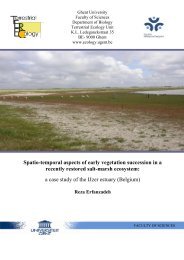PhD Arthur Decae 2010 - Ghent Ecology - Universiteit Gent
PhD Arthur Decae 2010 - Ghent Ecology - Universiteit Gent
PhD Arthur Decae 2010 - Ghent Ecology - Universiteit Gent
You also want an ePaper? Increase the reach of your titles
YUMPU automatically turns print PDFs into web optimized ePapers that Google loves.
Motivation for this thesis<br />
This thesis is written as an effort to contribute basic knowledge to the study of Arachnology,<br />
hoping this will help future research in a branch of biology that I regard as a potentially rich<br />
source of important scientific insight. All papers in this thesis contain original information on<br />
Mediterranean mygalomorph spiders provided in order to facilitate and stimulate more<br />
detailed future research and understanding of these fascinating, yet little known, animals.<br />
Aim<br />
The central goal of this thesis is to gain insight in the historical build-up of regional<br />
mygalomorph diversity in the expectation that this will aid a more general understanding of<br />
growing faunal complexity as it has occurred on earth.<br />
Personal Note<br />
When in 1983 I took my exams for a Master Degree in Biology at the University of<br />
Groningen one of the members in the jury asked me if I did not think that my studies had been<br />
too narrowly focused at just one animal group. I had worked on subjects in taxonomy,<br />
biogeography, ecology, ethology and comparative morphology of sensory organs all in one<br />
genus of mygalomorph spiders; the genus Cyrtocarenum Ausserer 1871. To my relief, and<br />
before I could answer, another member on the committee countered that there would have<br />
been no critical questions on this point if the one animal group had been fruit flies<br />
(Drosophila melanogaster), rats (Rattus norvegicus) or zebra fish (Brachydanio rerio). The<br />
point of course is that fruit flies, rats, zebra fish and a hand full of other animals are widely<br />
considered ideal model organisms for a range of interests in zoological research and that it<br />
remains to be seen if we could learn anything important from mygalomorph spiders. In fact, I<br />
believe we can learn something new and important from indiscriminately which animal we<br />
choose to study, but that the study of mygalomorph spiders offers more.<br />
The study of spiders in general offers more than the study of other animal groups because<br />
spiders are unique in producing a wide range of intricate and seemingly intelligent and/or<br />
geometric constructions made of a combination of material found in nature and self produced<br />
excretions: such as saliva and silk. These constructions, nests, webs, drag lines, cocoons,<br />
trapdoors, wrappings, ties and a number of other functional devices, may be seen as material<br />
expressions of complex behavior that no other animal, save the human species, leaves<br />
behind 1 . To produce their complex constructs spiders of course possess a range of<br />
morphological, physiological and neurological qualities not found in any other animal group<br />
and it is only because spiders are not of any obvious economical or medical interest that<br />
araneology (the study of spiders) is a relatively remote branch of the biological sciences 2 .<br />
This is to be regretted, because spiders not only possess all these unique qualities of direct<br />
biological interest, they also preserve, within their diversity, the reflection of an evolutionary<br />
history that dates back to the beginning of terrestrial animal life (<strong>Decae</strong> 1984). Although the<br />
fossil record of spiders is relatively poor, spiders do not fossilize easily (Selden & Penney<br />
<strong>2010</strong>), much of the history of spiders can be read from extant species. Apparently spiders<br />
have been a marked biological success throughout evolutionary time, surviving in great<br />
1 Beavers, birds, termites, bees and other animals produce amazing constructions in size and<br />
complexity, but rarely as versatile, intricate, geometrical and multifunctional as spiders and<br />
humans do (see e.g. Von Frisch 1974, Hansell 2007).<br />
2 Although properties of spider silk and venom in particular might offer prospects of medical,<br />
agricultural and other applications (e.g. Bailey & Chada 1968, Sterling et. al 1992, Patrick &<br />
Canard 1997, Novak 2001, Scheller et. al. 2001, Escoubas & Rash 2004) it seems to be very<br />
difficult to economically exploit spider products.










